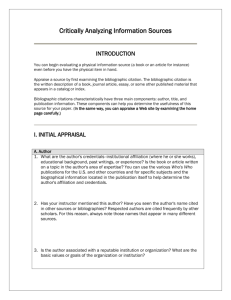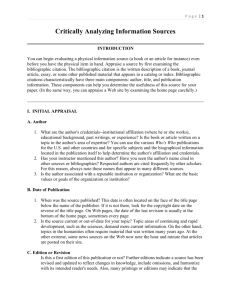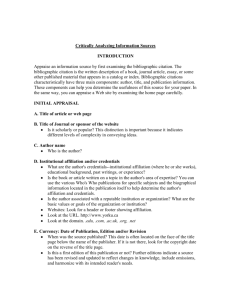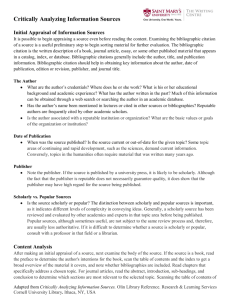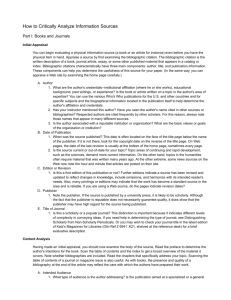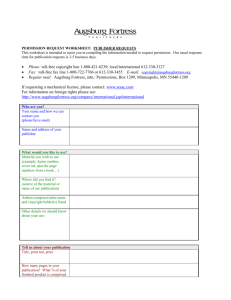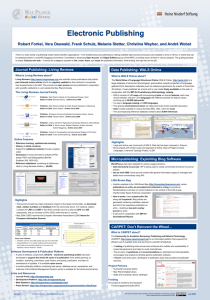How to Critically Analyze Information Sources
advertisement
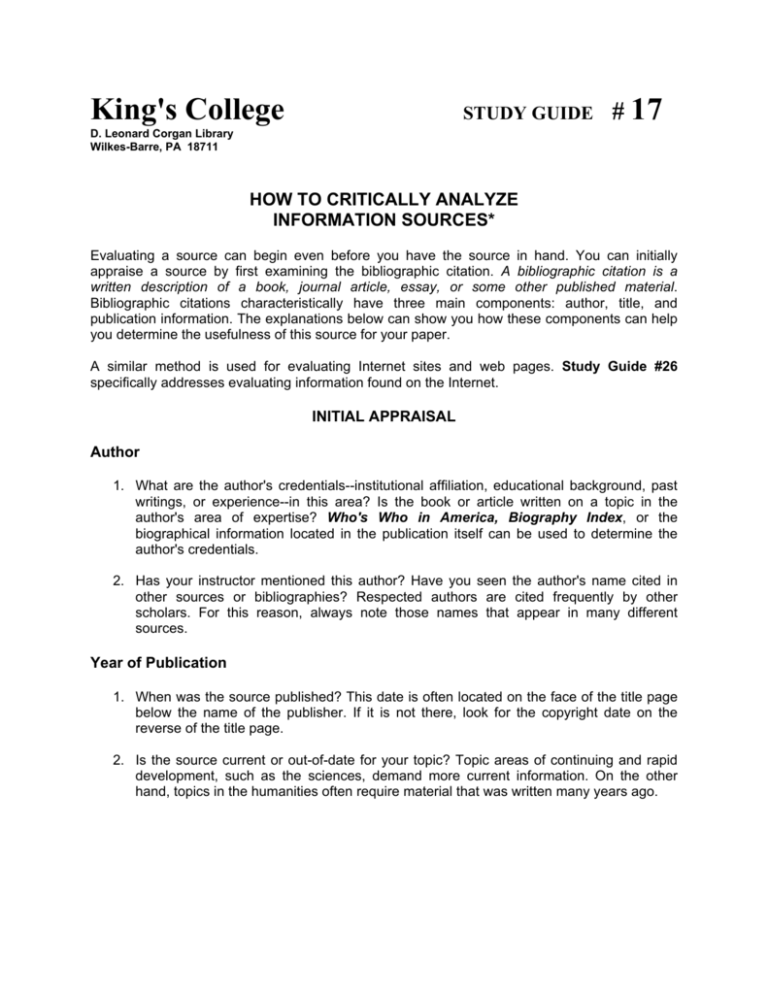
King's College STUDY GUIDE # 17 D. Leonard Corgan Library Wilkes-Barre, PA 18711 HOW TO CRITICALLY ANALYZE INFORMATION SOURCES* Evaluating a source can begin even before you have the source in hand. You can initially appraise a source by first examining the bibliographic citation. A bibliographic citation is a written description of a book, journal article, essay, or some other published material. Bibliographic citations characteristically have three main components: author, title, and publication information. The explanations below can show you how these components can help you determine the usefulness of this source for your paper. A similar method is used for evaluating Internet sites and web pages. Study Guide #26 specifically addresses evaluating information found on the Internet. INITIAL APPRAISAL Author 1. What are the author's credentials--institutional affiliation, educational background, past writings, or experience--in this area? Is the book or article written on a topic in the author's area of expertise? Who's Who in America, Biography Index, or the biographical information located in the publication itself can be used to determine the author's credentials. 2. Has your instructor mentioned this author? Have you seen the author's name cited in other sources or bibliographies? Respected authors are cited frequently by other scholars. For this reason, always note those names that appear in many different sources. Year of Publication 1. When was the source published? This date is often located on the face of the title page below the name of the publisher. If it is not there, look for the copyright date on the reverse of the title page. 2. Is the source current or out-of-date for your topic? Topic areas of continuing and rapid development, such as the sciences, demand more current information. On the other hand, topics in the humanities often require material that was written many years ago. Edition Is this a first edition or not? Further editions indicate a source has been revised and updated to reflect changes in knowledge or to include a broader range of information. Also, many printings or editions may indicate that the work has become a standard source in the area and is reliable. Publisher Note the publisher. If the source is published by a university press, it is likely to be scholarly. Although the fact that the publisher is reputable does not necessarily guarantee quality, it does show that the publisher may have high regard for the source being published. Title of Journal Is this a scholarly or a popular journal? This distinction is important because it indicates different levels of complexity in the material that is covered in the articles. If you need help in determining the type of journal, see Study Guide #16. CONTENT ANALYSIS Having made an initial appraisal, you should now examine the body of the source. Read the Preface to determine the author's intentions for the book. Scan the Table of Contents and the Index to get a broad overview of the material it covers. Note whether bibliographies are included. Read the chapters that specifically address your topic. Intended Audience What type of audience is the author addressing? Is the publication aimed at a specialized or a general audience? Is this source too elementary, too technical, too advanced, or just right for your needs? See Study Guide #16 for brief evaluative descriptions. Objective Reasoning 1. Is the information covered fact, opinion, or propaganda? It is not always easy to separate fact from opinion. Facts can usually be verified; opinions, though they may be based on factual information, evolve from the interpretation of facts. Skilled writers can make you think their interpretations are facts. 2. Does the information appear to be valid and well researched, or is it questionable and unsupported by evidence? Assumptions should be reasonable. Note errors or omissions. 3. Is the author's point of view objective and impartial? Is the text free of emotional or biased statements? 2 Coverage 1. Does the work update other sources, substantiate other materials you have read, or add new information? Does it extensively or marginally cover your topic? You should explore enough sources to obtain a variety of viewpoints. 2. Is the material primary or secondary in nature? Primary sources are the raw material of the research process. Secondary sources are based on primary sources. For example, if you were researching Adenauer's role in rebuilding West Germany, Adenauer's own writings would be one of many primary sources available on this topic. Others might include relevant government documents and contemporary German newspaper articles. Scholars use this primary material to help generate historical interpretations--a secondary source. Books, encyclopedia articles, and scholarly journal articles about Adenauer's role would be considered secondary sources. Choose both primary and secondary sources when you have the opportunity. Writing Style Is the publication organized logically? Are the main points clearly presented? Do you find the text easy to read, or is it stilted or choppy? Is the author repetitive? Evaluative Reviews 1. Locate critical reviews of books in a reviewing source, such as Book Review Index or Book Review Digest. Is the review positive? Is the book under review considered a valuable contribution to the field? Does the reviewer mention other books that might be better? If so, locate these sources for more information on your topic. For more information on how to find book reviews, see Study Guide #8 FINDING BOOK REVIEWS. 2. Do the various reviewers agree on the value or attributes of the book, or has it aroused controversy among the critics? *Adapted from materials developed by the URIS Undergraduate Library, Cornell University. Rev. Oct. 2003 3
